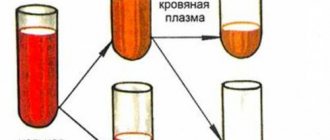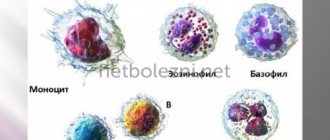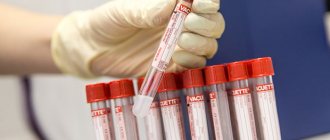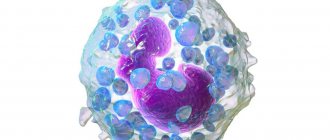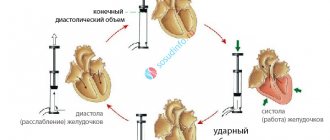Eosinophils consist of a bilobed nucleus and three types of eosinophil granules (lipid bodies, eosinophils, small and primary). They contain protein structures with the help of which foreign cells are neutralized. Eosinophils are quite large cells: their diameter reaches 20 microns.
Eosinophils got their name due to the fact that when stained according to Romanovsky, they are easily stained with eosin (an acidic dye), while other types of dyes have no effect on them. Eosin itself was invented in 1873 by the German scientist G. Caro and, due to its bright pink color, was named after the ancient Greek goddess of the dawn Eos (in the German version the name sounds like “eosin”).
Blood test for eosinophils
To determine the level of eosinophils, a general blood test is used, which is familiar to all of us since childhood. Eosinophils by themselves do not give an accurate idea of the nature of pathological changes in the body, however, in combination with other values of the leukocyte formula, they allow a specialist to judge the nature of the pathology. In the analysis form, eosinophils are designated as EO. Their content is indicated as a percentage of the total number of leukocytes. A formula is also used to calculate the absolute number of eosinophils in peripheral blood and it looks like this: number of leukocytes * 10 to the 9th power. For a general analysis, blood is most often taken from a finger prick, but venous blood is also suitable.
Figure 1. Causes of eosinophilia (increased number of eosinophils in the blood). Image: kavusta/Depositphotos
Role and functions in the body
Eosinophils, as a type of white blood cell, are responsible for protection against foreign agents, which can be microorganisms, chemicals, and toxins. Eosinophils are often called scavenger cells, which have a special task. They are considered the most sensitive to parasitic infections and pathological bacteria. They usually begin their work after lymphocytes and neutrophils. Their option in this case is to dissolve the remains of pathogenic microorganisms.
These cells also participate in the “antigen-antibody” reaction, due to which they control the release of histamine, better known as a substance that causes allergies. Thanks to this, eosinophils help reduce the aggressiveness of the immune system's response to foreign proteins. Such blood cells can also penetrate vascular walls and move through tissues to the site of damage or inflammation.
Among the lesser known areas of responsibility of eosinophils is the prevention of thrombosis. However, they also have a downside. These blood cells can become dangerous, for example, when they are associated with pathological changes. This happens with Loeffler's disease. This is an allergic disease, when the number of eosinophils in the blood increases, and infiltrates form in the lungs, which, however, quickly disappear.
Vital interest. Six naive questions about tests Read more
Indications for analysis
A complete blood test with a count of eosinophils is prescribed for most people who visit the clinic. The range of indications is very wide, but in modern clinical practice, the initial eosinophil count is most often used as a biomarker to assess the effectiveness of drugs prescribed to patients with bronchial asthma. In this regard, the absolute number of eosinophils is of greatest value to the physician.
Eosinophils belong to microphages. This means that they can only absorb small foreign particles.
The study is relevant when confirming a preliminary diagnosis, checking the effectiveness of the prescribed therapeutic course, assessing the state of a person’s health during medical examinations or medical examinations. The doctor also prescribes a general blood test in the postoperative period. In addition, counting eosinophils is important when the development of infectious, oncological and autoimmune diseases is suspected.
There are few eosinophils
{banner_banstat6}
The condition when eosinophils are low (less than 0.05 x 109/l) is called eosinopenia. This number of cells, first of all, indicates that the body does not cope well with the influence of various foreign factors inhabiting the external and internal environment.
The reason for the decrease in the body’s resistance, which is reflected in the blood test, is often various pathologies:
- Certain acute intestinal infections (dysentery, typhoid fever);
- Acute appendicitis;
- Sepsis;
- Injuries, burns, surgical operations;
- The first day of development of myocardial infarction;
- Acute inflammation (maybe zero, and then, on the contrary, above normal - a sign of recovery).
It should be noted that reduced eosinophils occur in cases far from those listed, and even from pathology in general: psycho-emotional stress, excessive physical activity, the influence of adrenal hormones.
It may seem only at first glance that this population of leukocytes is invisible (are they there or not?), since in a blood test their levels do not differ much. But eosinophils perform important functions, and their determination does not require any special preparation: a general blood test from a finger, which people call detailed (leukocyte formula), is a significant diagnostic indicator that can tell not only about the presence of the disease, but also about the stage of the pathological process .
Norms of eosinophils in the blood
When deciphering the analysis, the patient’s age is taken into account, since these factors affect the content of eosinophils in the blood.
Table 1. Norm of eosinophils by age
| Children under 5 years old | Children 5 – 14 years old | Adults |
| 0,5 – 7% | 1 – 5% | 0,5 – 5% |
It should also be taken into account that in women in the first days of menstruation there is a slight excess of the norm in the content of eosinophils, while after ovulation their number may be slightly below the norm.
In absolute terms, the norm for adults is 0.15-0.450X10.0⁹ per liter of blood plasma. Exceeding the normal percentage of leukocytes is called eosinophilia. There are three stages of eosinophilia:
1. Light (no more than 10% of the total number of leukocytes).
2. Average (up to 15%).
3. Heavy (over 15%).
There is safety in numbers
{banner_banstat2}
It should be noted that eosinophils are not the only cells involved in carrying out responses. At all stages, they are actively helped by a small but important group of granulocytes - basophils and mast cells. Basophils formed in the bone marrow do not create a reserve, but go directly to the periphery. Their blood contains only nothing - 0 - 1%. Their tissue form - mast cells or mast cells, live in large quantities in the skin, connective tissue and serous membranes. Basophils phagocytose weakly, do not live long, but are productive.
The granules of these cells contain histamine, serotonin, heparin, proteolytic enzymes, peroxidase and other biologically active substances, which will be released if necessary, for example, during an allergic reaction. Basophils, having a large number of receptors on their surfaces (for binding IgE, complement, cytokines) and “sensing something is wrong,” quickly migrate to the site of penetration of a foreign antigen, which is why they are almost always present in the areas of eosinophils’ main activity.
Causes of an increased number of eosinophils in the blood
An increase in the level of eosinophils indicates that the body is resisting the inflammatory process, and tissues and cells are experiencing oxygen deficiency. Possible reasons for the increase in the number of eosinophils:
- Allergy. This is one of the most common reasons. Hypersensitivity reactions always increase the production of eosinophils in the bone marrow. In turn, eosinophils reduce the production of allergy mediators.
Allergies are a common cause of elevated eosinophil levels. Photo: Dmyrto_Z / Depositphotos
- Asthma. In bronchial asthma, there is a moderate increase in the number of eosinophils in the blood, and in the allergic form they can also be found in sputum and bronchoalveolar fluid.
- Helminthic infestations. When infected with helminths, the number of eosinophils in the blood increases for two reasons: first, they release eosinophil cationic protein and reactive oxygen species to kill parasites. Secondly, the metabolic products of parasites provoke hypersensitivity reactions, and here the mechanism for increasing the production of eosinophils is the same as in allergies.
- Lung diseases. Despite the fact that the mechanism of increased eosinophil production in lung diseases has not yet been fully studied, experts note the relationship between these phenomena. Eosinophilia is observed in Churg-Strauss syndrome (in this case it reaches a frightening figure of 50%), allergic bronchopulmonary aspergillosis (an increase in the level of eosinophils is observed only in the acute phase and rarely exceeds 15%), as well as in eosinophilic pneumonia (up to 20%).
- Blood diseases. First of all, we are talking about hematological pathologies of a malignant nature (eosinophilic leukemia, myeloid leukemia). Eosinophilia is also characteristic of mastocytosis, but in leukemia its severity is much higher (up to 70%).
- Gastrointestinal diseases. An increased number of eosinophils in a general blood test is observed in gastritis, esophagitis and enterocolitis. All these diseases are accompanied by inflammatory processes, which causes accelerated formation of eosinophils.
- Oncological diseases. When confirming the diagnosis, the leukocyte count is not a priority indicator, but an increase in the number of eosinophils in malignant diseases is indeed observed. After therapeutic interventions such as radiotherapy, the increase in the number of eosinophils also increases significantly.
- Weakened immunity. In immunodeficiency conditions (Wiskott-Aldrich syndrome and Jobe syndrome), the level of eosinophils can reach 60%, which is associated with increased production of immunoglobulin E.
- Endocrine diseases. In diseases such as primary adrenal insufficiency (Addison's disease), congenital adrenal dysfunction, Schmidt's syndrome and panhypopituitarism, eosinophil levels increase to moderate levels and normalize after treatment with glucocorticoids.
- The recovery period after surgery. This is especially true when transplanting donor organs to a patient and removing the spleen.
If eosinophils are elevated
It is obvious that in children and adolescents the eosinophil count may increase to 6–7%, but this then goes away with age. If eosinophils are elevated in an adult, this indicates a pathology that requires diagnosis and treatment.
Eosinophils increase in children and adults in many diseases and conditions:
- infection with worms, especially lamblia, roundworms, strongyloides, echinococci, hookworms, schistosomes, toxocara, opisthorchiasis, pulmonary flukes and trichinella;
- asthma;
- allergy;
- hay fever;
- skin manifestations of allergies;
- malaria;
- recovery from infectious diseases;
- after taking antibiotics;
- serum sickness;
- hay fever;
- epidermolysis bullosa;
- atopic dermatitis;
- pemphigus;
- Dühring's dermatitis;
- nephroblastoma (Wilms tumor);
- carcinoma;
- cirrhosis of the liver;
- rheumatoid arthritis;
- pernicious (megaloblastic or B12-deficiency) anemia;
- all types of leukemia;
- lymphogranulomatosis (Hodgkin's lymphoma);
- polycythemia vera;
- fasciitis;
- Sezary syndrome;
- Wegener's granulomatosis;
- periarteritis nodosa;
- Churg-Strauss syndrome;
- sarcoidosis;
- pneumonia;
- Addison's disease;
- Loeffler's syndrome and Loeffler's endocarditis;
- condition after radiotherapy and irradiation;
- scarlet fever;
- Congenital heart defect;
- condition after removal of the spleen;
- GVHD after organ transplantation;
- tuberculosis of the lymph nodes;
- chorea;
- tumor metastases (especially to the bones and lungs);
- systemic lupus erythematosus.
An increase in these blood cells is called eosinophilia. The attending physician finds out the cause of this condition and looks for a way to eliminate it.
Causes of a low number of eosinophils in the blood
A decrease in the number of eosinophils below 0.02*109/l is called eosinopenia. There are several possible reasons:
- Taking glucocorticoids and steroids. These are hormonal drugs that help reduce the number of leukocytes (including eosinophils) in the blood due to their destruction. At the same time, eosinopenia is not a strong enough reason to discontinue a course of glucocorticoids, since in itself it does not pose a threat to health, while the therapeutic effect of these drugs for allergic reactions or autoimmune diseases fully justifies their use.
- Nervous tension and stress. During times of severe mental stress, depression and emotional turmoil, the level of cortisol, which is called the stress hormone, increases in the blood. It is cortisol that destroys eosinophils.
- Allergic reactions. The level of eosinophils in allergies is a rather paradoxical issue. With moderate hypersensitivity reactions, eosinophilia is observed, but with severe allergies, the level of eosinophils, on the contrary, decreases.
- Infectious diseases. Eosinopenia is characteristic of diseases of a viral and bacterial nature, which include coronavirus infection. A decrease in the number of eosinophils is also observed in purulent-septic processes (abscesses and phlegmon).
- Endocrine diseases. As we already know, an increase in the level of cortisol in the blood entails a decrease in the number of eosinophils. Cortisol is produced in the adrenal glands, so adrenal diseases (for example, Cushing's syndrome) cause eosinopenia.
- Bone marrow diseases. Since eosinophils are formed in the bone marrow, any associated pathologies and injuries cause eosinopenia.
- A decrease in the level of eosinophils in the blood can also be observed in the first days after a heart attack, with appendicitis, sepsis, acromegaly, lupus erythematosus, burns and injuries.
Figure 2. Eosinopenia (low eosinophil count). Dr Graham Beards / Wikipedia (CC BY-SA 3.0)
What are eosinophils?
Eosinophils are one of the types of white blood cells that are produced on a regular basis in the human bone marrow. Their maturation takes 3-4 days, after which they begin to circulate in the blood for several hours, gradually moving into the tissues of organs such as the lungs, skin and gastrointestinal tract. When their number begins to deviate from normal values, doctors call this situation a shift in the leukocyte formula and regard this fluctuation as a malfunction of the body.
Consequences of deviation from the norm
A change in the normal level of eosinophils in the blood is not a criterion by which one can get an idea of possible pathological changes in the body. Simply put, the level of eosinophils in the blood itself means little - you need to pay attention to the disease that caused its change. Therefore, the consequences can be very diverse - from completely insignificant (as in the case of physical activity) to deadly (for example, in the case of oncology).
Eosinophilia itself, in rare cases, can lead to damage to tissues in which the greatest accumulation of eosinophils is observed. The mechanism of such damage has not been fully studied to date, but it has been established that eosinophils exhibit the most severe damaging effect in conditions such as eosinophilic fibroplastic endocarditis and idiopathic hypereosinophilic syndrome. The nature of the damage directly depends on the duration of eosinophilia and the severity of eosinophilic tissue infiltration.
Simple example
{banner_banstat1}
Let's say, some agent enters the body, which is foreign to the latter.
- Eosinophils come into a state of “combat readiness”
: they migrate to the scene of the incident, extending their lifespan, increase the production of biologically active substances, and form adhesion molecules on their surfaces, through which cells cling to the epithelium. We can assume that the acquaintance took place, and the body responded with its reaction: cough, lacrimation, rash, etc. - The repeated visit of the alien agent does not go smoothly.
The allergen meets on its way immunoglobulin E, produced after the first time, which quickly recognizes the enemy, combines with it and forms the “AT-AG” complex. Eosinophils, capturing these complexes (phagocytosis), release mediators (main basic protein, leukotrienes, peroxidase, neurotoxin). The influence of these mediators is also well known to people who have a high response to stimuli, for example, bronchospasm of asthmatic origin (constriction of the bronchi, suffocation, mucus formation, etc.).
This behavior of eosinophils can explain the increase in their level when a person overcomes an infection
(many people themselves have noticed that at the end of the inflammatory process, the amount of E. in the analysis is increased), because they must collect all the reaction products between the pathogen and the antibodies that the body has produced to fight.
In this situation, an E. level above normal can be a very encouraging indicator: the disease is receding.
How to reduce the number of eosinophils in the blood
Eosinophilia is not an independent nosological entity, but only a consequence of a particular disease. Therefore, it cannot be treated in isolation - first of all, it is important to eliminate the cause of its occurrence, that is, the disease that caused the change in the leukocyte formula.
Possible treatment options:
- Desensitizing therapy. For allergies, antihistamines are used to reduce hypersensitivity reactions. Some of them may cause mild drowsiness (for example, chloropyramine), but newer generation drugs such as cetirizine, levocetirizine, desloratadine and rupatadine do not have this side effect and have a mild anti-inflammatory effect.
- Antibacterial therapy - for infectious diseases, antibiotics are prescribed (amoxicillin, ceftriaxone, azithromycin, erythromycin, etc.). The choice of antibacterial drug depends on the pathogen and its sensitivity to a specific group of antibiotics.
- Anti-inflammatory therapy. An increase in the level of leukocytes (including eosinophils) is observed during inflammatory processes. When they are severe, glucocorticosteroids (prednisolone) are used.
- Chemotherapy. This treatment method is aimed at eliminating malignant tumors. For this purpose, cytostatics and antimetabolites are used.
- Hormonal therapy. For multisystem diseases accompanied by immunodeficiency (for example, Jobe's syndrome), the use of steroid drugs and interferon gamma is indicated. Treatment is supplemented with antibiotics, calcineurin inhibitors, H1-histamine blockers, and antifungal drugs.
- Antihelminthic therapy. To combat helminthic infestations, drugs such as albendazole, levamisole, bephenia hydroxynaphthoate, piperazine, tetrachlorethylene, and mebendazole are prescribed. The choice of medication depends on the type of parasite and the stage of infestation. Additionally, antibiotics, enterosorbents, enzymes, probiotics, and glucocorticoids are prescribed.
Additionally, the following measures can be taken:
- Normalize your lifestyle. It is important to avoid frequent drinking of alcohol and give up cigarettes (or at least significantly limit the number of them).
- Avoid chronic intoxication. In people working in hazardous industries or living in environmentally unfavorable regions, the number of eosinophils in the blood increases as a result of constant chemical intoxication.
- Maintain a healthy diet. You should not overuse spicy, smoked, canned and fatty foods. To increase the level of eosinophils, you should limit the amount of meat, poultry and fish in your diet (consume mainly low-fat varieties). The menu should include yogurt, cheeses, vegetables, fruits, beans, bran and whole grain bread.
Giving up bad habits will help normalize the level of eosinophils. Photo: vgstockstudio / freepik.com
Main tasks and functions
{banner_banstat0}
Despite the short life of eosinophils, they are considered to be very important inhabitants of the blood, endowed with certain abilities to solve important problems:
- The main function is participation in tissue reactions (allergens, parasites, autoimmune processes).
- Responding to the influence of chemotactic factors, they, along with neutrophils, quickly migrate to the stimulus, that is, to the focus, in order to restore order there.
- By capturing histamine, eosinophils are able to phagocytose immune complexes “antigen-antibody - AT-AG”, produced mainly by immunoglobulins of class E (IgE), but at the same time, they have receptors that help cling to other protein molecules (immunoglobulins G, M , class I and II antigens of the leukocyte HLA system) and foreign cellular structures.
Meanwhile, these cells are noticeably inferior to neutrophils in their ability to digest captured products. eosinophil structure - E. contain enzymes, in particular, the main alkaline protein, which damages the larvae of parasites, which is why the number of these cells increases noticeably during helminthic infestation.
This feature of E. is widely used in the diagnosis of parasitic diseases, so it is not surprising that if a child has elevated eosinophils, then the parents immediately make a diagnosis. - Eosinophils produce a number of biologically active substances (histaminase, prostaglandin E, leukotrienes, etc.), and also participate in the formation of plasminogen, and, therefore, are involved in fibrinolysis.
However, all this is complex and incomprehensible, so let’s try to consider the main role of eosinophils using a simple example.
How to increase the number of eosinophils in the blood
A decrease in the level of eosinophils in the blood is a sign of weakened immunity. As in the case of eosinophilia, the primary pathology should be identified and eliminated, as well as lifestyle adjustments: minimize bad habits, ensure an adequate level of physical activity, and also take care of a normal daily routine (it is important to sleep at least 8 hours a day) .
The normalization of the leukocyte formula is facilitated by the consumption of vitamins B12, C, D. They can be obtained from food (meat, fish, cottage cheese, rose hips, currants, garlic), or from pharmacy multivitamins. It is advisable to exclude foods with a high allergenic potential: milk, soy, wheat, eggs, seafood, peanuts.
When treating diseases that result in eosinopenia, the same groups of drugs are often used as in the case of eosinophilia. For example, antibiotics are prescribed for infectious diseases, as well as diffuse and localized purulent-inflammatory processes (cellulitis and abscess). As mentioned earlier, allergies can provoke not only an increase, but also a decrease in the number of eosinophils in the blood, so antihistamines can also be used in the treatment of eosinopenia.
Increased eonophils (eosinophilia)
Eosinophilia (the same as eosinophilia) - an increase in the level of eosinophilic leukocytes in adults above 0.4 x 0.4 x 109/l, in children - 0.7 x 109/l is observed in the following pathological conditions:
eosinophilia
- Any diseases that have an allergic onset: bronchial asthma, skin lesions (eczema, psoriasis, dermatitis, lichen planus), periarteritis nodosa, hay fever, eosinophilic vasculitis, helminthic infestation. This category should also include a disease of hypersensitivity to certain drugs and other chemicals, for example, when exposed to antibiotics (penicillin, streptomycin). However, they do not necessarily have to get inside; sometimes simply coming into contact with them is enough for the skin of the hands to begin to itch and crack, which is often observed among nurses working in hospitals.
- Reaction to the administration of antibacterial drugs.
- Infectious-inflammatory process (recovery stage).
In other frequent cases, the cause of an increase in eosinophils is other diseases:
- Decreased functionality of the thyroid gland (hypothyroidism).
- Rheumatic fever (rheumatism).
- Parasitic diseases.
- Acute leukemia.
- Malignant neoplasms.
- Tuberculosis.
- Hereditary eosinophilia.
- Exudative reactions of various origins.
- Vagotonia (irritation of the vagus nerve), vegetative-vascular dystonia.
Considering the increased level of eosinophils in the blood, it is useful to dwell on the phenomenon of hypereosinophilia (hypereosinophilic syndrome) and its complications, which largely affect the heart muscle, causing necrosis of its cells.
Hypereosinophilic syndrome
{banner_banstat5}
The reasons for the increase in eosinophils up to 75% have not been thoroughly studied, however, it has been noted that helminthic infestation, periarteritis nodosa, cancers of various localizations, eosinophilic form of leukemia, bronchial asthma and drug-induced disease play an important role in the development of this condition. Well, there are plenty of reasons...
Eosinophilia that persists at high levels for several months makes one suspect a process that destroys the tissue of parenchymal organs
(heart, liver, kidneys, spleen), and in other cases even affecting the central nervous system.
dermatitis with hypereosinophilic syndrome
In hypereosinophilic syndrome (HES), not only an increase in the number of eosinophils is observed, but also their morphological change. The altered cells can cause irreparable damage to the heart (Loeffler's disease). They leak into the muscular (myocardium) and inner (endocardium) membranes and damage the heart cells with protein released from eosinophil granules. As a result of such events (necrosis), conditions are created in the heart for increased thrombus formation, damage to the ventricles (one or both), valvular and subvalvular apparatus with the development of relative insufficiency of the mitral and/or tricuspid valve.
Why are these cells dangerous?
If a high level of eosinophils remains in the body for a long time, this can cause tissue damage and even partial destruction. Some diseases, for example, Loeffler's disease, are directly related to the pathology of the described cells and pose a great danger to health.
All this suggests that the eosinophil count should always be kept normal, since they can be not only beneficial, but also harmful.
For any diseases accompanied by changes in eosinophils, it is recommended to take Transfer Factor. This is a modern natural immunomodulator, currently sold as a dietary supplement. Indications for taking the drug may include bronchial asthma, urticaria, allergies, atopic dermatitis and all other diseases in which an increase in eosinophils is observed.
As a rule, in case of allergic nature of diseases, drugs affecting the immune system are contraindicated. However, Transfer Factor is a happy exception. The fact is that it does not enhance current immune processes, which can lead to increased allergies, but normalizes the functioning of the immune system. This not only “puts in place” the eosinophil count, but also promotes a speedy recovery.
Eosinophils and cytotoxic immunity:
Let us remember that immune defense consists of three components:
- phagocytosis (destruction of pathogens by devouring them),
— humoral immunity (fighting aggressors by releasing antibodies);
- cytotoxic immunity (destruction of an object through contact of an immune cell with it).
In addition to the ability to phagocytose particles, eosinophils “know how” to exhibit cytotoxic properties.
What do eosinophils show? An increase in their number occurs if a person, for example, becomes infected with parasites. These cells have the ability to destroy “pests” and are therefore activated in patients with helminthiasis, infected with protozoa, etc. In addition, eosinophils exhibit a bactericidal effect and respond to the penetration of bacteria into the body.
During certain pathological processes, they quickly move to the site of inflammation, come into contact with microbes and secrete enzymes that have a toxic effect on them.




